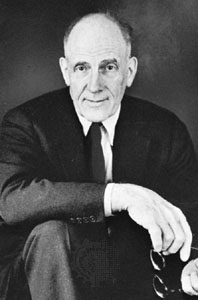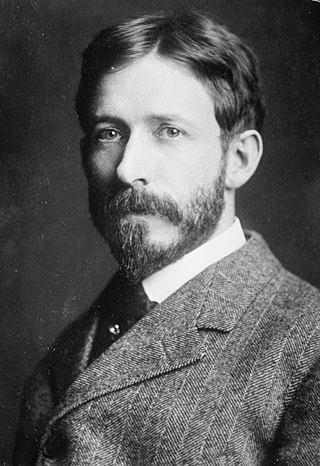
Wallace Kirkman Harrison was an American architect. Harrison started his professional career with the firm of Corbett, Harrison & MacMurray, participating in the construction of Rockefeller Center. He is best known for executing large public projects in New York City and upstate, many of them a result of his long and fruitful personal relationship with Nelson Rockefeller, for whom he served as an adviser.

Robert Moses was an American urban planner and public official who worked in the New York metropolitan area during the early to mid 20th century. Despite never being elected to any office, Moses is regarded as one of the most powerful and influential individuals in the history of New York City and New York State. The grand scale of his infrastructural projects and his philosophy of urban development influenced a generation of engineers, architects, and urban planners across the United States.

The Robert F. Kennedy Bridge is a complex of bridges and elevated expressway viaducts in New York City. The bridges link the boroughs of Manhattan, Queens, and the Bronx. The viaducts cross Randalls and Wards Islands, previously two islands and now joined by landfill.
The Brooklyn–Battery Tunnel, officially the Hugh L. Carey Tunnel and commonly referred to as the Battery Tunnel or Battery Park Tunnel, is a tolled tunnel in New York City that connects Red Hook in Brooklyn with the Battery in Manhattan. The tunnel consists of twin tubes that each carry two traffic lanes under the mouth of the East River. Although it passes just offshore of Governors Island, the tunnel does not provide vehicular access to the island. With a length of 9,117 feet (2,779 m), it is the longest continuous underwater vehicular tunnel in North America.

Wastewater treatment is a process which removes and eliminates contaminants from wastewater and converts this into an effluent that can be returned to the water cycle. Once returned to the water cycle, the effluent creates an acceptable impact on the environment or is reused for various purposes. The treatment process takes place in a wastewater treatment plant. There are several kinds of wastewater which are treated at the appropriate type of wastewater treatment plant. For domestic wastewater, the treatment plant is called a Sewage Treatment. For industrial wastewater, treatment either takes place in a separate Industrial wastewater treatment, or in a sewage treatment plant. Further types of wastewater treatment plants include Agricultural wastewater treatment and leachate treatment plants.

Castle Clinton is a restored circular sandstone fort within Battery Park at the southern end of Manhattan in New York City. Built from 1808 to 1811, it was the first American immigration station, predating Ellis Island. More than 7.5 million people arrived in the United States at Fort Clinton between 1855 and 1890. Over its active life, it has also functioned as a beer garden, exhibition hall, theater, and public aquarium. The structure is a New York City designated landmark and a United States national monument, and it is listed on the National Register of Historic Places.

The First Battle of Fort Wagner was fought on July 10 and 11, 1863, on Morris Island in Charleston harbor during the American Civil War. An attempt by the Union Army to capture Fort Wagner was repulsed. The more famous Second Battle of Fort Wagner, which involved an assault by the 54th Massachusetts, would be fought on July 18.

Milorganite is a brand of biosolids fertilizer produced by treating sewage sludge by the Milwaukee Metropolitan Sewerage District. The term is a portmanteau of the term Milwaukee Organic Nitrogen. The sewer system of the District collects municipal wastewater from the Milwaukee metropolitan area. After settling, wastewater is treated with microbes to break down organic matter at the Jones Island Water Reclamation Facility in Milwaukee, Wisconsin. The byproduct sewage sludge is produced. This is heat-dried with hot air in the range of 900–1,200 °F (482–649 °C), which heats the sewage sludge to at least 176 °F (80 °C) to kill pathogens. The material is then pelletized and marketed throughout the United States under the name Milorganite. The result is recycling of the nitrogen and phosphorus from the waste-stream as fertilizer. The treated wastewater is discharged to Lake Michigan.
Moses N. Baker was a noted editor and author in the field of drinking water history and technology. His most important book is still used today: The Quest for Pure Water: The History of Water Purification from the Earliest Records to the Twentieth Century. He was also active in the field of public health holding several positions on boards of health at the state and local levels.

WSP USA, formerly Parsons Brinckerhoff, is an American multinational engineering and design firm. The firm operates in the fields of strategic consulting, planning, engineering, construction management, energy, infrastructure and community planning. It is a subsidiary of WSP Global.
Elsie Eaves was a pioneering American female engineer, the first female associate member of the American Society of Civil Engineers (ASCE), and a founding member of the American Association of Cost Engineers.
Elkan Naumburg (1835–1924) was a New York City merchant, banker, philanthropist and musicologist, best remembered for his sponsorship of the arts in Manhattan. From the last quarter of the nineteenth century, he used his wealth to promote public interest in symphonic and "semi-classical" music by helping to form and establish the Oratorio Society of New York and funding construction of the Naumburg Bandshell, which honors his name, on the Concert Ground of the Central Park Mall.

Edward Abraham Byrne (1864–1938) was an American civil engineer responsible for the construction of a number of bridges in the boroughs of New York. He was of Irish descent.
Elsie Margaret Binger Naumburg was an American ornithologist.
Carl Binger (1889–1976), AKA Carl A. L. Binger, was a 20th-century American psychiatrist. He wrote books and articles on a wide range of topics, including medicine and psychiatry, and testified in the trial of Alger Hiss.

The Municipal Asphalt Plant is a former asphalt plant at York Avenue and 91st Street on the Upper East Side of Manhattan in New York City, United States, housing the Asphalt Green recreation center. The asphalt plant was completed in 1944 to designs by Ely Jacques Kahn and Robert Allan Jacobs. The current structure, originally a mixing plant, reopened as the George and Annette Murphy Center in 1984. The asphalt plant, which formerly included a conveyor belt and storage facility, produced asphalt that was used to pave roads in Manhattan. The Murphy Center is a New York City designated landmark and is listed on the National Register of Historic Places.

George McAneny, was an American newspaperman, municipal reformer and advocate of preservation and city planning from New York City. He served as Manhattan Borough President from 1910 to 1913, President of the New York City Board of Aldermen from 1914 to 1916, and New York City Comptroller in 1933. He also held several other positions throughout his career, serving as an executive officer of the New York City Civil Service Commission in 1902, secretary of the New York Civil Service Reform League (1894-1902), executive manager of The New York Times (1916-1921), and president of the Regional Plan Association (1930-1940).

George Warren Fuller was an American sanitary engineer who was also trained in bacteriology and chemistry. His career extended from 1890 to 1934 and he was responsible for important innovations in water and wastewater treatment. He designed and built the first modern water filtration plant, and he designed and built the first chlorination system that disinfected a U.S. drinking water supply. In addition, he performed groundbreaking engineering work on sewage treatment facilities in the U.S. He was President of both the American Water Works Association and the American Public Health Association, and he was recognized internationally as an expert civil and sanitary engineer.

The mayoralty of Fiorello La Guardia lasted from January 1, 1934, to January 1, 1946, while he served as the 99th Mayor of New York City. His mayoralty presided over New York City during the Great Depression and World War II. He is considered the builder of modern New York City due to his numerous infrastructure projects. He replaced John P. O'Brien and was succeeded by William O'Dwyer.

The New York City mayoral election of 1933 took place on November 7, 1933 in New York City. Incumbent Democratic Mayor John P. O'Brien, who was elected in a special election after the resignation of Mayor Jimmy Walker, faced Republican Congressman and 1929 mayoral candidate Fiorello La Guardia, and former acting mayor and President of the New York City Board of Aldermen Joseph V. McKee, who became acting mayor after Walker's resignation until the special election, and ran on the Recovery Party line.















